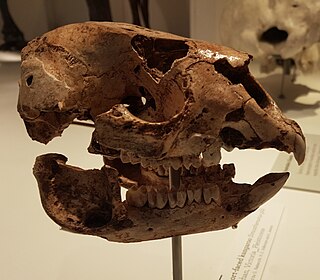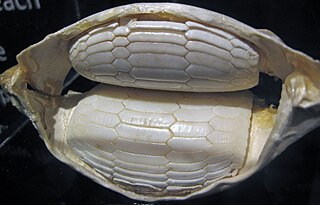
Diprotodon is an extinct genus of marsupial from the Pleistocene of Australia containing one species, D. optatum. The earliest finds date to 1.77 million to 780,000 years ago but most specimens are dated to after 110,000 years ago. Its remains were first unearthed in 1830 in Wellington Caves, New South Wales, and contemporaneous paleontologists guessed they belonged to rhinos, elephants, hippos or dugongs. Diprotodon was formally described by English naturalist Richard Owen in 1838, and was the first named Australian fossil mammal, and led Owen to become the foremost authority of his time on other marsupials and Australian megafauna, which were enigmatic to European science.

Homotherium is an extinct genus of machairodontine scimitar-toothed cat that inhabited North America, South America, Eurasia, and Africa during the Pliocene and Pleistocene epochs from around 4 million to 12,000 years ago. In comparison to Smilodon, the canines of Homotherium were shorter, and it was probably adapted to running down rather than ambushing prey.

Obdurodon is a genus of extinct platypus-like Australian monotreme which lived from the Late Oligocene to the Late Miocene. Three species have been described in the genus, the type species Obdurodon insignis, plus Obdurodon dicksoni and Obdurodon tharalkooschild. The species appeared much like their modern day relative the platypus, except adults retained their molar teeth, and unlike the platypus, which forages on the lakebed, they may have foraged in the water column or surface.

The order Peramelemorphia includes the bandicoots and bilbies. All members of the order are endemic to Australia-New Guinea and most have the characteristic bandicoot shape: a plump, arch-backed body with a long, delicately tapering snout, very large upright ears, relatively long, thin legs, and a thin tail. Their size varies from about 140 grams up to 4 kilograms, but most species are about one kilogram.

The dire wolf is an extinct canine. The dire wolf lived in the Americas during the Late Pleistocene and Early Holocene epochs. The species was named in 1858, four years after the first specimen had been found. Two subspecies are recognized: Aenocyon dirus guildayi and Aenocyon dirus dirus. The largest collection of its fossils has been obtained from the Rancho La Brea Tar Pits in Los Angeles.

Phascolarctos is a genus of marsupials with one extant species, the koala Phascolarctos cinereus, an iconic animal of Australia. Several extinct species of the genus are known from fossil material, these were also large tree dwellers that browsed on Eucalyptus leaves.

Thylacoleo is an extinct genus of carnivorous marsupials that lived in Australia from the late Pliocene to the Late Pleistocene, often known as marsupial lions. They were the largest and last members of the family Thylacoleonidae, occupying the position of apex predator within Australian ecosystems. The largest and last species, Thylacoleo carnifex approached the weight of a lioness. The estimated average weight for the species ranges from 101 to 130 kg.

Procoptodon is an extinct genus of giant short-faced (sthenurine) kangaroos that lived in Australia during the Pleistocene Epoch. P. goliah, the largest known kangaroo species that ever existed, stood at about 2 m (6.6 ft). They weighed about 200–240 kg (440–530 lb). Other members of the genus were smaller, however; Procoptodon gilli was the smallest of all of the sthenurine kangaroos, standing approximately 1 m tall.

Sthenurinae is a subfamily within the marsupial family Macropodidae, known as short-faced kangaroos or sthenurine kangaroos. No members of this subfamily are extant today, with all becoming extinct by the late Pleistocene. Procoptodon goliah, the largest macropodid known to have existed, was a sthenurine kangaroo, but sthenurines occurred in a range of sizes, with Procoptodon gilli being the smallest at the size of a small wallaby.

Palorchestes is an extinct genus of large terrestrial, herbivorous Australian marsupial of the family Palorchestidae, living from the Miocene through to the Late Pleistocene. Like other palorchestids, it had highly retracted nasal region suggesting that it had a prehensile lip, as well as highly unusual clawed forelimbs that were used to grasp vegetation.

Anancus is an extinct genus of "tetralophodont gomphothere" native to Afro-Eurasia, that lived from the Tortonian stage of the late Miocene until its extinction during the Early Pleistocene, roughly from 8.5–2 million years ago.

Sthenurus is an extinct genus of kangaroos. With a length around 3 m (10 ft), some species were twice as large as modern extant species. Sthenurus was related to the better-known Procoptodon. The subfamily Sthenurinae is believed to have separated from its sister taxon, the Macropodinae, halfway through the Miocene, and then its population grew during the Pliocene.

Simosthenurus, also referred to as the short-faced kangaroo, is an extinct genus of megafaunal macropods that existed in Australia, specifically Tasmania, during the Pleistocene. Analysis of Simosthenurus fossils has contributed to the finding that there are three lineages of macropods: Sthenurinae, Macropodinae, and Lagostrophinae. The genus Simosthenurus was among the sthenurines.

Josephoartigasia is an extinct genus of enormous dinomyid rodent from the Early Pliocene to Early Pleistocene of Uruguay. The only living member of Dinomyidae is the pacarana. Josephoartigasia is named after Uruguayan national hero José Artigas. It contains two species: J. magna, described in 1966 based on a left mandible, and J. monesi, described in 2008 based on a practically complete skull. Both are reported from the San José Member of the Raigón Formation by the Barrancas de San Gregorio along the shores of Kiyú beach.

Hulitherium tomasetti is an extinct zygomaturine marsupial that lived in New Guinea during the Pleistocene. The species name honours Berard Tomasetti, a Catholic priest in Papua New Guinea, who brought the fossils to the attention of experts.

Paramylodon is an extinct genus of ground sloth of the family Mylodontidae endemic to North America during the Pliocene through Pleistocene epochs, living from around ~4.9 Mya–12,000 years ago.

Durophagy is the eating behavior of animals that consume hard-shelled or exoskeleton bearing organisms, such as corals, shelled mollusks, or crabs. It is mostly used to describe fish, but is also used when describing reptiles, including fossil turtles, placodonts and invertebrates, as well as "bone-crushing" mammalian carnivores such as hyenas. Durophagy requires special adaptions, such as blunt, strong teeth and a heavy jaw. Bite force is necessary to overcome the physical constraints of consuming more durable prey and gain a competitive advantage over other organisms by gaining access to more diverse or exclusive food resources earlier in life. Those with greater bite forces require less time to consume certain prey items as a greater bite force can increase the net rate of energy intake when foraging and enhance fitness in durophagous species.

Hipposideros besaoka is an extinct bat from Madagascar in the genus Hipposideros. It is known from numerous jaws and teeth, which were collected in a cave at Anjohibe in 1996 and described as a new species in 2007. The site where H. besaoka was found is at most 10,000 years old; other parts of the cave have yielded H. commersoni, a living species of Hipposideros from Madagascar, and some material that is distinct from both species. H. besaoka was larger than H. commersoni, making it the largest insectivorous bat of Madagascar, and had broader molars and a more robust lower jaw. As usual in Hipposideros, the second upper premolar is small and displaced from the toothrow, and the second lower premolar is large.
Riversleigh fauna is the collective term for any species of animal identified in fossil sites located in the Riversleigh World Heritage Area.

Congruus is an extinct genus of macropod known from the Late Pleistocene of Australia. There are two species, Congruus kitcheneri, which was originally described as a species of Wallabia, and Congruus congruus. Specimens are known from Mammoth Cave, Western Australia, the Thylacoleo Caves and the Naracoorte caves in South Australia. Potential material is also known from Eastern Australia. The morphology of the skull and limbs suggests that they were semi-arboreal browsers, moving slowly through trees, though they were larger than and not as specialised for climbing as living tree kangaroos. They are thought to be members of the tribe Macropodini, and close relatives of the extinct genus Protemnodon.



















